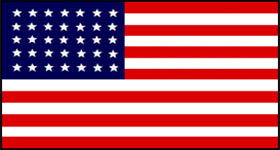Civil War Battles |
Colonial Wars |
American Wars |
Link To This Page — Contact Us —
The Battle of Honey Springs Depot
March 17, 1863 in Muskogee and McIntosh County , Oklahoma
Maj. Gen. James G. Blunt
| Forces | Killed | Wounded | Captured |
| 3,000 | 17 | 60 | - |
Confederate Forces Commanded by:
Brig. Gen. Douglas H. Cooper
| Forces | Killed | Wounded | Captured |
| - | 150 | 400 | - |
**Missing and Captured
Conclusion: Union Victory

BATTLE SUMMARY
On July 15th, Brig. Gen. Douglas H. Cooper, commanding the 1st Brigade/Indian Troops, learned that the Arkansas River had become fordable and feared a threat to his security should Union forces under Brig. Gen. James G. Blunt decide to cross and attack him in his position along Elk Creek, 25 miles south. Blunt, correctly surmised that Confederate forces were about to concentrate and would then attack his force at Fort Gibson. He decided to defeat the Confederates at Honey Springs Depot before they were joined by Brig. Gen. William Cabell's brigade, advancing from Fort Smith, Arkansas. Union and Confederate troops had frequently skirmished in the vicinity of Honey Springs Depot. On the evening of the 15th, he began his crossing and the next evening had soime 3,000 men, mostly Indian and black troops, along with 2 artillery batteries, on the march toward Cooper.
On the 17th, Blunt skirmished with Confederate troops early in the morning, and by midafternoon, full-scale fighting ensued. The Confederate troops, themselves composed largely of Cherokee and Choctaws, somewhat outnumbered their attackers, but almost from the start they began to suffer from inferior and wet gunpowder, causing misfires, and ammunition. Blunt advanced toward the Confederates in a single line of battle, his small detachment of cavalry dismounted and fighting on foot.
Starting about 10:30 A.M., the fighting continued for 2 hours. Cooper believed that he had repulsed at least 1 Union attack before it started to rain on the battlefield. The downpour rendered useless many of the weapons already suffering from damp powder, and Cooper had to retire to find fresh ammunition. Reconnoitering from high ground near the creek, he soon saw the full extent of Blunt's command and that it threatened to turn his left flank. His situation began to disintegrate. Col. Tandy Walker, with 2 Indian regiments, misunderstood Cooper's orders and marched away from the battle. Then Cooper found that his men holding a vital crossing on Elk Creek were giving away, threatening to allow Blunt to cross and flank him once again. From then, the retreat spread through the Confederate command without orders. Cooper managed a fair rearguard action; his war-whooping Choctaws charged into Blunt until they too were demoralized and retreated. Any possibility of the Confederates taking Fort Gibson was gone. Following this battle, Union forces controlled Indian Territory, north of the Arkansas River.
Blunt wrote after the battle, "I never saw such fighting as was done by the Negro regiment....The question that negroes will fight is settled; besides they make better solders in every respect than any troops I have ever had under my command."
